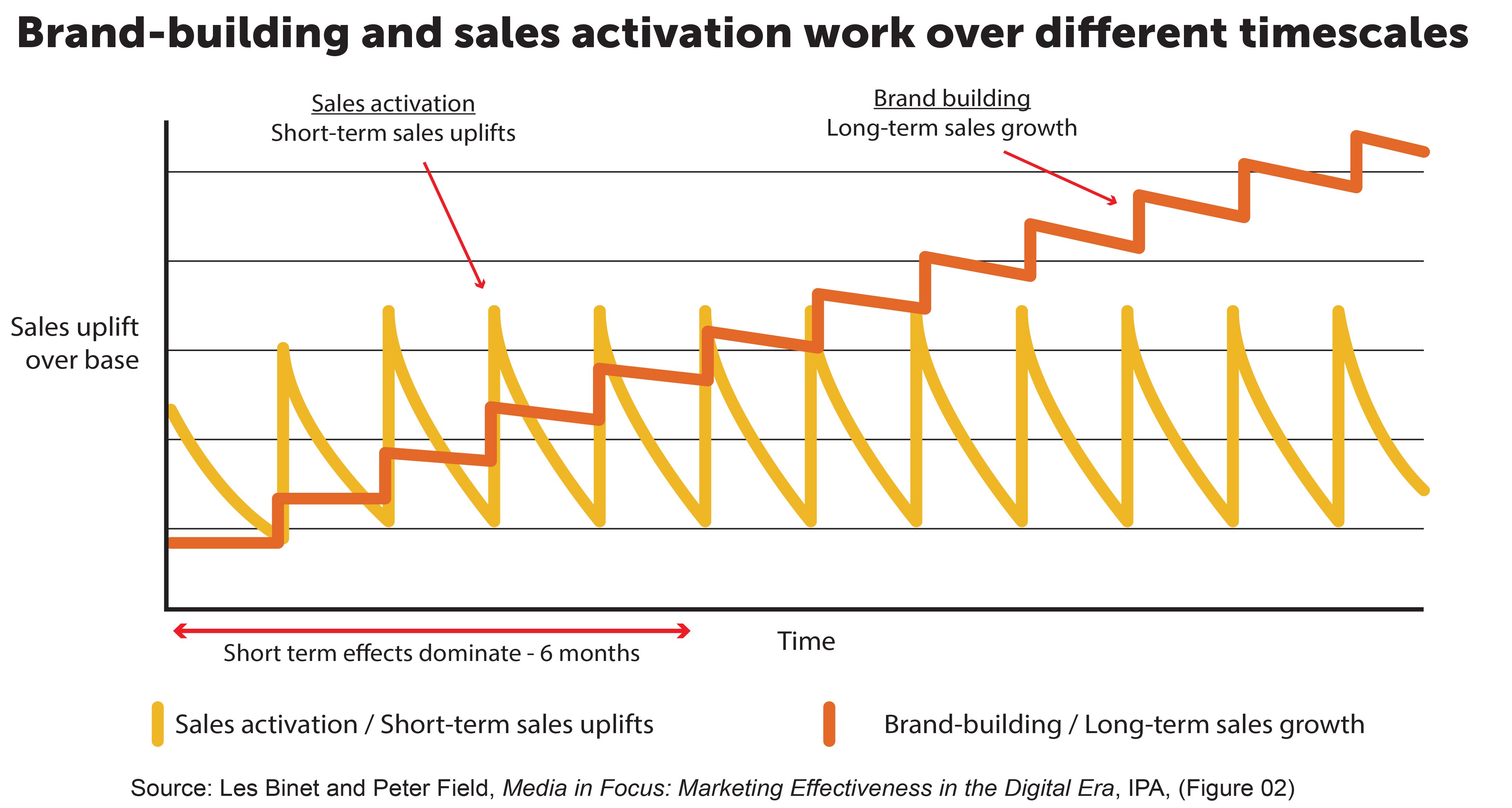The Evolution of Brand Development in Digital Marketing
What’s the best marketing strategy for scaling your business? Allocating your digital marketing dollars and building a proper funnel can be tricky. How can you be sure that your marketing strategy will drive sales conversions? Striking the right balance between direct marketing and brand value is essential.
Direct Response Digital Marketing vs. Brand Development:
Direct marketing efforts are easily trackable and provide short-term gains but can diminish over time and don’t support long-term growth. A weighted focus on direct marketing makes sense for small businesses and start-ups in the short term.
Brand or “awareness marketing" is hard to track; it doesn’t provide quick returns but has substantial long-term benefits. Brand marketing sustains big companies, and it’s essential for scaling small-to-midsize companies.
So how do you build a balanced, data-driven, sustainable marketing program?
Direct Marketing Value is Easy to Understand
Direct marketing (or “direct response marketing”) is measurable – that is, there is an immediate and quantifiable result from campaign expenditures. Direct marketing has a clear ROI. As marketing guru, Seth Godin puts it, “Direct marketing is outbound, measured, and designed to pay for itself.”
An excellent example of this is a Google Ad. Clicks and conversions are measured, and those metrics determine the value of the ad.
Direct marketing is very appealing – there is no leap of faith. Marketers can see immediate, direct, measurable results and adapt accordingly. Direct marketing sells a product. Calculate the clicks, spend, and conversion, and you get a concise picture of the campaign’s effectiveness and the ROI.
Direct marketing is excellent for commodified consumer products but diminishes the more specialized and valuable the product or service becomes. Consumers are more likely to click on a Google ad to buy a T-shirt than to click on a Google ad to purchase a high-value or long-term product or service.
The Limitations of Direct Marketing
In the early days of digital advertising, early adopters enjoyed tremendous success – the first banner ad in 1994 had a CTR of 44%! However, as more and more companies digitized their marketing and Google discovered that they could charge per click, we began down a path of self-obsolescence.
According to Hubspot, the average CTR on display ads today is roughly 0.06%. This is explained by a concept known as brain overload. Put simply; our brains have a limited capacity.
An endless stream of seemingly valueless information is more than we can process. The deluge of digital advertising is overwhelming, and we have learned to ignore most of it. Ninety-six percent of brands are running PPC ads on Google. That saturation is why between 70% and 80% of users completely ignore paid advertisements.
Direct marketing expires; it calls for immediate action, and if you fail to act, the prospect is lost until you touch them again. It doesn’t build a relationship, only a temporary touchpoint.
This is where brand marketing comes in. Brand marketing builds long-term relationships. Brand value builds relationships.
Sales Activation vs. Brand Activation
The difference between the two approaches is analogous to The Turtle and The Hare, and brand marketing is slow and steady, like the turtle.
Les Binet is a superstar advertising analyst who has done extensive studies of the long-term effects of brand development. Les explains it this way, “Brand building is about getting a long-term flow of sales, revenue, and profit, now and into the future.” His groundbreaking work with Peter Field produced this comparison graph. They use the terms “sales activation” (direct) and “brand building” (brand):

Why the Term “Brand Marketing” Causes Panic
Brand Marketing can be terrifying to a small-to-midsize business. It can sound vague and abstract. The main reason is that it hasn’t been immediately measurable historically. It’s been almost impossible to see a clear and immediate return on brand spending.
Brand activation can seem like an expense that companies can't afford.
Unlike direct marketing, building brand awareness isn’t an expense; it’s an investment. Direct marketing sells a product; brand marketing builds the value of a company. That’s a critical differentiator: direct is a short-term expense, brand is a long-term investment.
It’s easy to understand why small-to-midsize businesses tend to undervalue brand development; they focus on short-term goals and product sales rather than building brand value. It makes sense; aim for quick sales today, build revenue and think about the brand later. The catch is that future sales will diminish without brand marketing, and you fail to distinguish yourself in the marketplace.
How Brand Development Works
In the digital arena, a company’s brand identity intersects its messaging, product offering, and public perception. Buyers are more educated than ever, and they read reviews. A prospect wants to know what kind of customer experience you provide. Potential customers want to know how good your product or service is and what current customers say about you.
Brand marketing should say, “Here we are; we are professional, reputable, stable, and exemplary,” and it should provide proof.
Brand building strategies are becoming more critical than ever for sales organizations. Brand development boosts awareness, and it differentiates a company in the “sea of sameness” in the poorly segmented digital market. Strong brand awareness doesn’t mean that prospects won’t ignore your ads and messaging, but as a colleague of mine likes to say, it means that “they will know who they are ignoring.”
In other words, you will still be reaching them even if they don’t take immediate action. As you reach them, over time, you build a passive relationship. Think about what I said earlier regarding how easy it is to ignore direct marketing ads. A strong brand will boost your direct campaigns and vice versa.
Data Drives all Efforts
As the direct advertising feedback loop gets smaller, we see results almost in real-time. The flow of data is so strong that if applied correctly - there is very little guesswork in which efforts will bear fruit and which won’t.
This makes it much harder to take on marketing campaigns that don’t have a lot of nearly instantaneous feedback. The risk seems higher than it ever did. Paying for direct marketing campaigns feels like betting money on a sure thing with a tangible return. Paying for brand building campaigns feels like gambling on a long shot, with no easily quantifiable return.
ROI cycles seem to be shrinking as well - from annual, to quarterly, to monthly, to weekly - simply because we can monitor more incrementally and make adjustments to hit fractional goals. That shrinking cycle has been the enemy of brand advocates the world over - until now.

Some Good News – Attribution Reporting
We know that brand marketing works and how important it is to enterprise companies and long-term growth. It also makes a company more robust in the face of adversity, market pressures, and competition. We understand the value, but when we can’t see it, it takes a leap of faith to actively invest in it.
The radical change in brand marketing is a greater ability to evaluate efficacy. The once mysterious effect of brand marketing is starting to evolve into something more concrete. The driver of that change is sales attribution reporting.
Attribution reporting isn’t a new idea, it originated to track data points and create models based on that data to analyze the effect of marketing efforts. In a nutshell, we can see the effect of marketing efforts outside the direct response loop that we’ve previously relied on.
Multi-touch attribution (MTA) is a way of tracking all marketing touchpoints, allowing marketers to see conversion points and points of influence. In other words, all of the touchpoints that effectively drive toward conversion.
If we can see that a potential customer engaged with a social media post, watched a YouTube video, read two blogs, and then clicked an ad and converted, we can begin to see the tangible effects of brand marketing in the short term. Multi-touch attribution models paint this picture.
By understanding customer behaviors at scale - for instance, if 75% of our converted leads have a given pattern of branded content interaction - we know that those efforts are effective. If we dial in on our tracking, we can see exactly which actions contribute to conversions and which don’t.
Trends in Brand Development
It’s not hard to imagine how valuable multi-touch attribution will be in the coming years as automation platforms become more affordable and sophisticated. Brand spending is increasing across the board, which means that to stay competitive, we can’t ignore brand marketing. The brands that are spending the most tend to be the most secure and resource-rich, but that doesn’t mean that smaller companies shouldn’t take heed.
If you are a small-to-midsize company, you may not be ready for a 60/40 or greater brand-to-direct budget allocation. However, you should be building your brand activation program, and the intelligent way to do that is with attribution models.
The increase in data tracking puts a much greater focus on marketing ROI. ROI metrics on direct marketing are rapid and clear, while the relationship between brand marketing and sales can be hard to see. However, brand marketing does have an ROI, and it’s increasingly apparent and trackable.
As companies gain a greater understanding of increasing brand awareness, brand spending is increasing. Companies that ignore the value of brand development will fall behind. Brand marketing will continue to evolve, and it’s wise to keep a keen eye out as it develops. Knowing which campaigns contribute to conversions is the best way to find the right direct-to-brand balance and build a strong and holistic marketing strategy.
See also: Blogging Tips for Businesses




